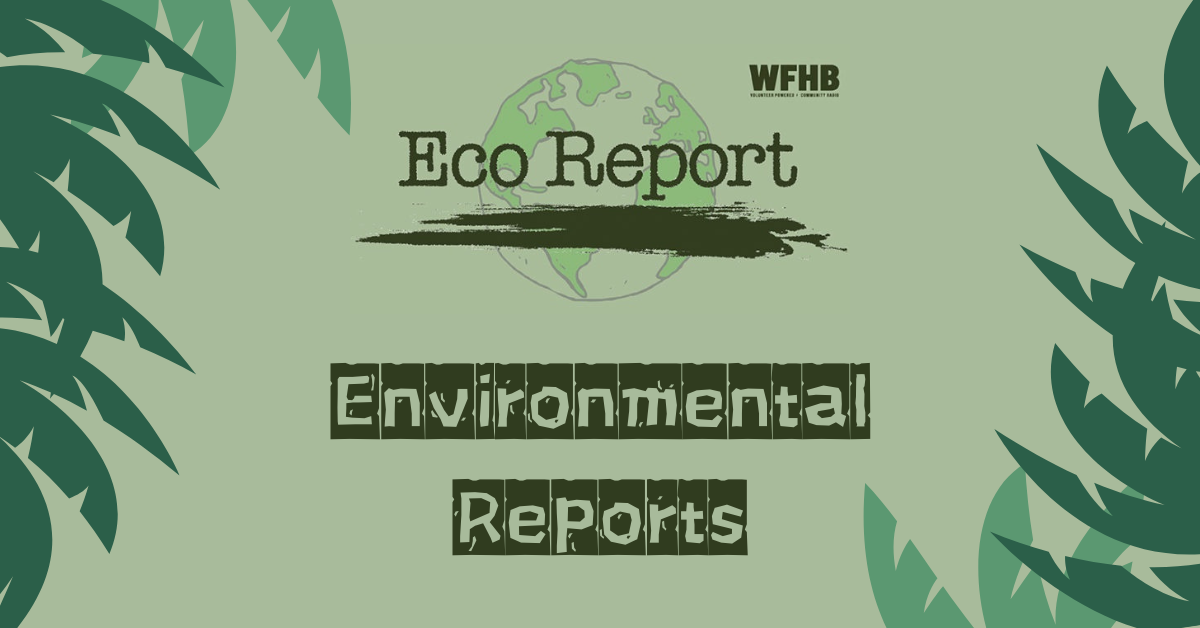Podcast: Play in new window | Download (Duration: 30:07 — 68.9MB)
On this Fund Drive edition of Eco Report, Kade Young continues his discussion with Maggie Sullivan, Watershed Coordinator for the Friends of Lake Monroe. They will discuss how healthy the lake is and how long it will survive.

Inside Climate Change reports a federal program is expanding electric school bus fleets, but there are still some bumps in the road. Often times, you can hear it—and smell it—before you see it: The steady sputtering of a bright yellow bus rolling around the corner to retrieve kids during the school year. Each year, school buses around the U.S. carry students more than 4 billion cumulative miles. However, the majority of them are powered by diesel-fueled engines that pre-date the Environmental Protection Agency’s emissions standards.
Along with releasing climate-warming emissions, these diesel engines produce toxic gases such as nitrogen oxides and particulate matter, which can cause an array of health problems; research shows that diesel school buses exacerbate childhood asthma and drive increased reports of pneumonia and bronchitis. But momentum is building around a federal initiative to clean up schools’ gas-guzzling bus fleets by replacing them with cleaner electric convoys. In 2022, the Biden administration announced the first investments from the EPA’s “Clean School Bus Program,” which was launched to help speed up the electric transition in schools. As of January 2024, the EPA has provided around $1.84 billion to fund 5,103 “clean” school buses—96 percent of them electric—and charging infrastructure at 642 school districts in states, territories and tribal lands, according to a recent report.
Powered by large batteries, electric school buses do not produce any tailpipe emissions. In fact, the EPA says switching even just half of U.S. school buses from diesel to electric could avoid 2.1 million tons of carbon dioxide emissions annually. A large-scale transition to electric vehicles in general would also have widespread benefits for pediatric lung health by reducing asthma attacks and cases of bronchitis, according to a report from the American Lung Association published in February. The problem? Electric school buses cost around $400,000 each, roughly three to four times as much as diesel-powered buses. That doesn’t factor in the additional tens of thousands of dollars required to build out infrastructure such as electric charging stations. For many school districts, shouldering the cost for this transition alone is impossible, which is why the EPA’s grants and rebates are coming into play.
The U.S. urgently urgently needs a bigger grid. There’s a fast solution. A rarely used technique to upgrade old power lines could play a big role in fixing one of the largest obstacles facing clean energy, two reports found. As explained by the New York Times, one of the biggest obstacles to expanding clean energy in the United States is a lack of power lines. Building new transmission lines can take a decade or more because of permitting delays and local opposition. But there may be a faster, cheaper solution, according to two reports.
Replacing existing power lines with cables made from state-of-the-art materials could roughly double the capacity of the electric grid in many parts of the country, making room for much more wind and solar power. This technique, known as “advanced reconductoring,” is widely used in other countries. But many U.S. utilities have been slow to embrace it because of their unfamiliarity with the technology as well as regulatory and bureaucratic hurdles, researchers found. “We were pretty astonished by how big of an increase in capacity you can get by reconductoring,” said Amol Phadke, a senior scientist at the University of California, Berkeley, who contributed to one of the reports released Tuesday.
Working with GridLab, a consulting firm, researchers from Berkeley looked at what would happen if advanced reconductoring were broadly adopted. Today, most power lines consist of steel cores surrounded by strands of aluminum, a design that’s been around for a century. In the 2000s, several companies developed cables that used smaller, lighter cores such as carbon fiber and that could hold more aluminum. These advanced cables can carry up to twice as much current as older models.
In this weeks feature, Kade Young and Maggie Sullivan, the Watershed Coordinator for the Friends of Monroe Lake, discuss the history of the lake and its crucial role in the Bloomington water supply.

Are you looking for a way to make a difference on environmental issues? EcoReport is looking for reporters, engineers, and segment producer to report facts on how we’re all affected by global climate disruption and the ongoing assaults on our air, land and water. We also celebrate ecologists, tree huggers, soil builders and other champions who actively protect and restore our natural world, particularly those who are active in south central Indiana. All levels of experience and all ages are welcome, and we provide the training you’ll need. WFHB also offers internships. To volunteer for Eco Report, call at (812) 323-1200, or e-mail [email protected].

- Learn all about Owls during the Nature Sounds Owls concert tonight, April 26th, from 6:30 to 7:30 pm at the Rogers Family Park in the barn. Musical guest is Stephanie Heidemann. Bring your own seating.
- Enjoy Wildflowers along the Fire Tower at McCormick Creeks State Park on Saturday, May 4th from 2 to 4 pm. Meet naturalists Jess and Kyle in front of the Canyon Inn to enjoy a guided hike on Trail 4.
Credits:
Headlines Norm Holy
News feature Kade Young
Script Julianna Dailey
Events Calendar Julianna Dailey
Producer Kade Young
Producer Noelle Herhusky-Schneider
Engineer Branden Blewett
 WFHB Bloomington Community Radio
WFHB Bloomington Community Radio


